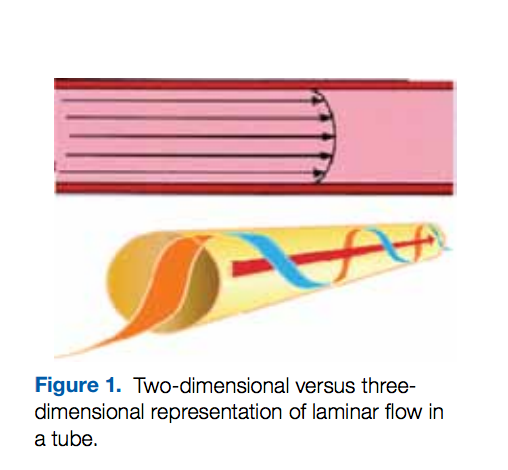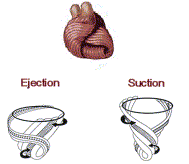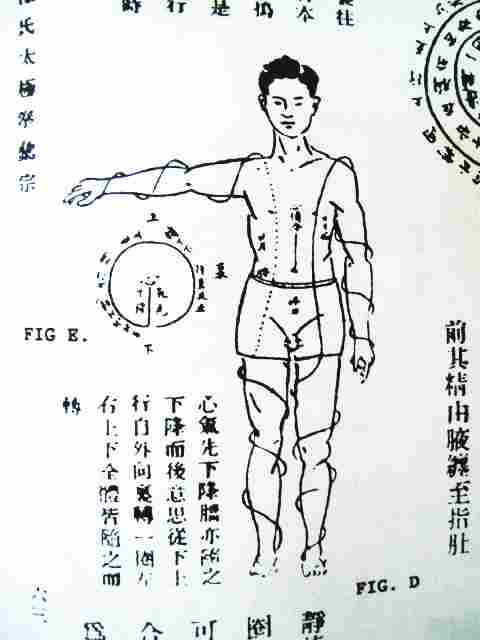
28 Feb Spiral Anatomy
Our bodies are full of spirals. A friend posted on the Ancestral Movement Facebook Group recently about “cosmomimicry” and her own increasingly strong life-changing experiences with a kind of Sufi whirling practice. She asked about movements embodying the “torus” structure, with a link to an article, and what this all might mean for physical practice. I didn’t particularly like the article (it was certainly well-meaning, but lost me once it started describing the centre of the human body as a “singularity”) but I felt the need to respond with a few bits of under-appreciated anatomy and physiology to back up my friend’s experiences.
“When I looked at the heart for the first time I saw a circumferential basal loop. And then I saw a descending limb and an ascending limb. And they curl around each other at a helix and a vortex, except for the ventricle. And the angles at which they go is about 60 degrees. 60 degrees down and 60 degrees going up, and they cross each other in that way. For years people had wondered why this happened. I realized this is really a spiral. And I began to think about spirals. And I began to understand that spirals are almost the master plan of nature in terms of structure and in terms of rhythm.… if you pick the middle of the spiral up you form a helix. And of course the heart is a helix.”
-Dr. Gerald Buckberg, M.D.
Firstly, we have the “helical heart”. At the centre of our being we have this huge muscle pumping constantly throughout every minute of every day of our entire lives, and it turns out that it’s fibres are arranged in a complex, and beautiful, spiral or helix.
Helicalheart.com looks to be an excellent website, the video section especially is worth checking out. The mechanics and electrophysiology of the heart are actually a bit different, and a lot more beautiful, than what a lot of us learned back in anatomy and physiology class. For more images, medical illustrator Laura Maaske wrote a great post with lots of her old drawings called “Untying the knot, your heart is actually a spiral“. Anyone wanting to read some of the original research on this can check out “The structure and function of the helical heart” by Dr F Torrent-Guasp, the surgeon who made the discovery.
The heart starts out as a tube, then twists into a helix as we develop. Once we are grown, it has a wonderfully intricate helical structure, and the blood pumping through moves into and out of the heart via a cluster of thick blood vessels (the ascending and descending aorta, the pulmonary arteries and pulmonary veins) which are also arranged in a spiral.
https://youtu.be/oHMmtqKgs50
If anyone’s keen to look into the evolution or comparative anatomy of hearts and blood vessels in other creatures, here is a nice thorough article in the encyclopedia Britannica online: the vertebrate circulatory system.
So the heart is a helix, and the major blood vessels emerging from it have a helical structure, and then as it turns out the blood itself moves through the vessels in what is called “spiral laminar flow”:
“Recent work in cardiac and peripheral vascular blood flow has shown evidence for an elegant complexity to flow within the heart and in the large to medium arteries. Blood flow is normally described as laminar in that the blood travels smoothly or in regular paths. The velocity, pressure, and other flow properties at each point in the fluid remain constant, all parallel to each other. Our understanding has revolved around a two-dimensional representation of flow within three-dimensional (3-D) blood vessels. However, MRI and color Doppler flow imaging techniques have demonstrated that there is a spiral/helical/rotational property to laminar blood flow.”
So what this means is that interoception – the feeling of physiological activity taking place inside the body – has potential to awaken us to a feeling of “spiralling energy” in our centres, and this might at first seem to be weird and wacky or “cosmic”, but it’s also just a fact of our anatomy. I’m not trying to say this is mundane, quite the opposite! I think it’s incredibly magical. The sensation then of a helical pump pumping a viscous fluid in a spiralling flow through some spiralling vessels could certainly lead to a greater sense of harmony with the rest of the living world, with a felt sense in the body that mirrors the trees spiralling up towards the sky, the spiralling growth of sea shells, movements of the planets and the moon and the images that now fill our heads of planets orbiting the sun and DNA and the beautiful four-armed spiral shape of our galaxy.
 “Spiralling energy” is something we hear about quite a bit in certain circles, namely the Chinese (and a couple of Japanese) “Internal” martial arts. In fact the concept seems to show up in all sorts of esoteric and pseudoscientific circles, which is kind of the point of this post – not to say “it’s all true!!” but to show that while the concept might get lumped in with a lot of exaggerated claims, at a basic level it actually has a very sound and solid physical basis.
“Spiralling energy” is something we hear about quite a bit in certain circles, namely the Chinese (and a couple of Japanese) “Internal” martial arts. In fact the concept seems to show up in all sorts of esoteric and pseudoscientific circles, which is kind of the point of this post – not to say “it’s all true!!” but to show that while the concept might get lumped in with a lot of exaggerated claims, at a basic level it actually has a very sound and solid physical basis.
For some reason, a lot of people are very attached to the idea of “energy” as being something non-physical – how this is possible is never explained, it’s just felt to be true, often based on vague (mis-)interpretations of words like “qi” or “prana”. If only we could describe an experience as “the pleasant and exciting feeling of spiralling movement within the body”! But, apparently the experience of moving, living flesh and blood by a conscious mind evolved over four billion years is not special enough, or something, so we have to call it “energy”? I know it’s just language, but one of the main reasons I dislike “energy” talk is that I think it contributes to people’s body denial. Living meaty flesh is heavy, gross, icky, wet, dark and completely mortal, while “energy” and “vibrations” are none of those things and more easily associated with “light”. I’m not sure, but I guess everyone is free to call things whatever they want, and describe their own lives using whatever language they choose, and I should stop trying to be the scientific language police or I’ll give myself a heart attack.
So on that note, here are some serious men in hats, spinning around in worship, and let me say for the record that I thoroughly approve.
https://www.youtube.com/watch?v=luDklth_mbM
A lot of these arts and traditions also emphasise the importance of practicing spiralling movement, for reasons ranging from superior biomechanics to the previously stated sense of harmony with the cosmos. In the next post I’ll give a brief introduction to some of the spiral anatomy of the muscular system, and have a look into some of these movement traditions.




ryan
Posted at 12:54h, 28 Februaryso much yes. what a teaser for your next post! ive been toying around w/ the mission statement of my “reverse engineering TKTN” study group, heres what ive landed on as of now:
Exploring the 3 building blocks of healing & joyful group practice:
1. repetitive rhythmic cycles (shifting out of linear time into cyclical time)
2. call and response chanting/singing (listen/respond, hear your as part of a chorus)
3. tri-axial spiraling movements and upper-body/stepping coordination (tri-axial coordination of the limbs, spine, pelvis and shoulders, stepping, turning, and shifting weight in rhythm, experiencing the spiral nature of our physical structure)
simon
Posted at 16:16h, 28 Februarysounds like fun!
Thor
Posted at 20:52h, 28 FebruaryIs there a Deeper meaning why mostly everybody always turn to the left side. It s a phaenomen that i watched in different classes during warm ups. When People should run circles they always run left (heart to the Circle Center)
Pingback:Spiral anatomy continued (again) | Ancestral Movement
Posted at 18:32h, 18 March[…] the previous couple of posts I described the spiral anatomy of the heart and major blood vessels, and the spiral anatomy of the many muscles wrapping the torso and spine, […]
Stefano
Posted at 21:26h, 23 MarchWARAKU
looking for this jappanise art base on the body spirale movement.
nicola
Posted at 14:56h, 03 Mayso much yes! thank you for sharing and offering possibility for new experience with heart! i just spent several days exploring the pelvic bone structure within movement and what new life stirs in fostering real relationship with anatomical structures is rich. this just opened a new gateway!
Laura Maaske
Posted at 07:58h, 12 MayI love your article. Wanted to let you know that I’ve written on a related topic, with some paintings I made of the heart. I’d be happy to link your article to mine, as I think our readers would like the connection. I’ll be adding new illustrations and new research tonight.
http://medimagery.com/news/2013/10/untying-the-knot-your-heart-is-actually-a-spiral/
Best,
Laura Maaske
simon
Posted at 09:01h, 21 MayThanks Laura! Really nice to hear from you, I loved your article and drawings as well.
Pingback:Primary and Secondary Research – Ben's Bored Journal
Posted at 04:28h, 25 April[…] Spiral Anatomy […]